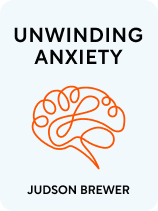

This article is an excerpt from the Shortform book guide to "Unwinding Anxiety" by Judson Brewer. Shortform has the world's best summaries and analyses of books you should be reading.
Like this article? Sign up for a free trial here.
What are the best mindfulness exercises for anxiety? Can you practice these exercises every day?
In Unwinding Anxiety, Judson Brewer argues that you can defeat anxiety with mindfulness. Brewer provides a set of mindful exercises you can use to improve your life by overcoming anxiety.
Read below for three mindfulness exercises to cope with anxiety.
Mindfulness and Curiosity Practices
Brewer delves into some specific practices that can help us through mindfulness meditation. We’ll explore some mindfulness exercises for anxiety to use throughout your daily life.
1. Mindfulness 101: Watching the Breath
One basic mindfulness tool—and the core of many meditation practices—is paying attention to the breath. Brewer recommends that when you notice yourself getting anxious—or are about to do some other behavior you’d rather change—you should pause and become aware of your breathing. Pay attention to the physical sensations of breathing (such as its length, depth, and so on), and focus on the part of your body where you most feel the breath.
Brewer argues that watching the breath breaks the anxiety habit loop and automatically replaces it with mindful curiosity. In other words, if you watch your breath whenever you start to feel anxious, then instead of feeding the anxiety by engaging with it—through worrying, coping behaviors, active avoidance, and so on—you instead relate to your anxiety as a neutral observer. Doing so disarms the anxiety and starves the habit cycle that gives rise to it in the first place.
That said, watching the breath doesn’t automatically make anxious thoughts and feelings go away—and that’s not the goal. In fact, once you’ve used your awareness of the breath to adopt a mindful attitude, Brewer suggests that you pay attention to where in your body you most feel the anxiety. He says you can imagine breathing into that area to focus your attention there, and you can even imagine breathing out some of the unpleasant sensations.
2. Cultivating Curiosity
One of the benefits of observing the breath is that doing so encourages curiosity—which, as we’ve seen, Brewer considers an ideal antidote to anxiety. He also offers several additional mindfulness exercises for anxiety that are specifically designed to help you respond with curiosity even in difficult circumstances.
For example, Brewer recommends that when you’re stressed, anxious, or otherwise upset and you feel closed down, you say “hmm” out loud to yourself—just as you would if you encountered something interesting or surprising. He argues that saying “hmm” triggers you to become curious about whatever’s going on.
Similarly, he says that deliberately widening your eyes can trigger a curious (rather than fearful or angry) response. He points to research suggesting that we open our eyes wide when we’re trying to take in information and narrow them when trying to block out sensory input (as when something disgusts us) or focus on action (as when we’re fighting or fleeing).
3. Everyday Mindfulness
Once you start practicing mindfulness in response to anxiety, Brewer recommends that you incorporate mindfulness throughout your daily life. He suggests that doing so lowers stress, increases your enjoyment of life, and helps you spot new anxiety loops as they arise. To that end, he offers a few more mindfulness exercises for anxiety designed to strengthen and expand your mindfulness practice.
Noting
Noting is a technique for avoiding distraction when you’re trying to be mindful. Brewer explains that if you’re watching the breath or other bodily sensations and you notice yourself thinking, feeling strong emotions, or feeling the urge to do something else, you should simply note the distraction by naming what it is—“thinking,” “feeling,” “hearing,” “soreness,” and so on—and gently return to your practice. Doing so encourages you to be mindful by paying close attention to whatever’s going on right now and also gives you distance from your thoughts and emotions by showing you that you can experience and acknowledge them without getting caught up in them.
(Shortform note: Noting can also help you recognize patterns in your thinking, which, as we’ve seen, is a key step in treating anxiety. Still, as meditation teacher Andy Puddicombe explains, you don’t need to note every single thought you have—just the ones that distress you or threaten to distract you from your mindfulness.)
Loving Kindness Practice
Finally, Brewer recommends extending your mindfulness by taking up loving kindness practice—a meditation technique whereby you offer positive wishes toward others and/or yourself to develop compassion, love, and joy. Brewer says that loving kindness is a powerful antidote to anxiety because it relaxes you, reduces stress and self-judgment, and engenders positive, gentle emotions.

———End of Preview———
Like what you just read? Read the rest of the world's best book summary and analysis of Judson Brewer's "Unwinding Anxiety" at Shortform.
Here's what you'll find in our full Unwinding Anxiety summary:
- How to recognize and counteract anxiety with mindfulness
- Why anxiety becomes is toxic if left untreated
- A three-step method for treating anxiety






